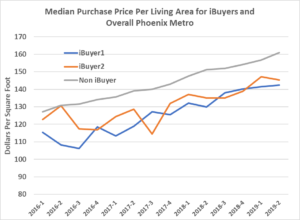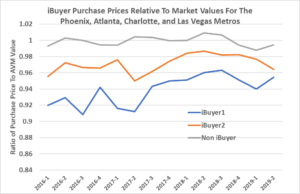Download a PDF file of this research paper here.
Introduction
iBuyers offer quicker closings for sellers who would like to avoid the uncertainty of knowing when and if their home will sell. For motivated sellers who want a predictable sale date and need to move, perhaps a long distance from the current location, there is no question that iBuyers have provided a welcome alternative to traditional brokerage. Rather than compare iBuyers to traditional brokerage, as if the market was required to offer only one choice, we welcome a plethora of choices for home buyers and sellers. A robust and competitive market will provide different levels of services and charges to compensate providers for cost of service and risk. Here we address the question “Who are the iBuyers, how do they make money, what risks do they face, and what are the benefits for sellers?”
iBuyer background
The largest iBuyer, based on capital raised to date, is OpenDoor, but there are several others including OfferPad, Zillow Offers, Redfin, Knock, Realogy CataLIST, Perch, Keller Offers from Keller Williams, and many others. Some of these are local brokerage firms like SDCountyhomebuyers.com and we can expect a few localized iBuyers in every major metro. In fact, iBuying can be viewed as comparable to corporate relocation companies that have been around for many years, providing a guaranteed a sale for employee transfers, but now offered to the general public and paid for directly by sellers.
When did they start?
OpenDoor, now with over 1300 employees, headquartered in Phoenix, started in 2014 and is available in at least 20 major cities as of July, 2019. OpenDoor has been reported to have raised at least $1.3 billion dollars and purchased over 10,000 homes in 2018, more than three times the number of homes as the next closest competitor, OfferPad.[1] They also sold more than double the number of homes as OfferPad.[2] OpenDoor has now teamed up with Redfin.
OfferPad started in 2015. Another iBuyer, Knock is slightly different, in that it provides a home trading platform, assisting the seller by temporarily buying your new home and then selling your old home. As such Knock is combining the functions of a short-term banker with those of a brokerage firm. Zillow Offers jumped in after witnessing the growth of OpenDoor and is on pace to enter more markets by 2020 than OpenDoor and OfferPad combined, based on their listing data base presence throughout the United States.
The industry is still in its infancy and represents an extremely small part of the overall market, but one can’t ignore any financial innovation that has been growing in market share at over 25% per year. Eventually the most efficient firms, that make the fewest mistakes, with enough capital to reach significant market share will remain. At the same time, traditional brokerage firms are likely to add this option for sellers, if they have not already done so.
What do iBuyers charge compared to traditional transactions?
Traditional brokers fees generally range from 5% to 7% of the sales price, with 1% to 4% charged to sellers and 3% typically paid to buyer’s agents, known as a co-op fee. In addition to this cost, buyers typically pay some closing costs including lender related charges in the range of 1% to 3%. Aside from direct transaction costs, the sellers must often spend time and money on home repairs, frequently clean and leave their home for showings, and bear the uncertainty of not knowing when and if the home will sell.
iBuyers charge sellers a “convenience fee” of 6% to 9.5%, some also charge the seller for fees typically paid by buyers at closing adding another 1% or more. Most iBuyers will inspect the home, assess a generous home repair allowance and negotiate a (an additional) credit to handle such repairs.3 Some iBuyers like OfferPad will pay for moving costs within 50 miles and allow a few extra days after closing of residence. Overall the total direct costs, ignoring repair credits, will run 7% to 10% for an iBuyer, versus the typical 5% to 9% combined seller and buyer costs with a traditional broker. Yet, that is not the end of the story or comparison.
iBuyer Prices Versus Traditional Market Prices
Comparing the transaction costs above of iBuyers, one might conclude that for 2% to 5% more than a traditional agency, I can sell my home with certainty, avoid the hassles of showing and shift the risk of not knowing when the home will sell to the iBuyer. iBuyers are well aware of the risks inherent in selling a home. Using their data analysis, they should, hopefully, know about competing inventory, how long it takes to sell on average, and how much they will need to sell below market, if they wish to sell fast. iBuyers also need to be compensated for their capital costs for typically 60 to 80 days. Because of these risks and costs, iBuyers cannot afford to buy all homes offered at all times of the year, without a conservative offer price. The more unique the home, the worse the season for selling, or the more competing inventory is present in the local market, the more conservative will be the offer price.
Using public record data to identify iBuyer and non-iBuyer purchases, Exhibit 1 below shows quarterly median single family prices paid on a per square foot of living area basis in the Phoenix metro for two of the larger iBuyers compared to the rest of the (non-iBuyer) market. It should be mentioned that these prices represent the purchases which we could easily identify and totaled approximately 4000 transactions.
Exhibit 1: Phoenix, AZ Metro Single Family Prices Paid Per Square Foot by Buyer Type
While the graph above in Exhibit 1 is a good way of seeing trends in home values and purchase prices by buyer type, a more accurate way of measuring iBuyer discounts paid is to control for size, age and a host of other variables influencing value on both the iBuyer purchased properties and all other buyers of similar properties.
To do this, we compared the purchase prices with our CA (Collateral Analytics) Value AVM (Automated Valuation Model) since the latter correlates very well with actual market values. Here we analyze four active markets.
Exhibit 2 below summarizes the analysis and includes approximately 6000 transactions. Here we see the median discounts of 4.5% to 6.9% for iBuyer1 and 2.0% to 3.3% for iBuyer2. Exhibit 2 shows quarterly median values of this ratio for the two iBuyers along with the same for purchases of non-iBuyer transactions for four major iBuyer markets, – i.e. Phoenix, Atlanta, Charlotte, and Las Vegas. The difference between the top line and the iBuyer lines represents the average spread from our estimate of market value.
One might look at Exhibit 2 and conclude that the spread below market value paid by iBuyers is declining. This may be true, or it could be that the pressure to deploy capital has reduced the spread as the iBuyer market matures. Ultimately, the spread will be at an appropriate level to compensate the iBuyers for liquidity risks and capital costs.
Exhibit 2: Median Purchase Price-To-AVM Ratio for iBuyer and Non-iBuyer Transactions
The median purchase price discounts for the four markets studied are shown on an annual percentage basis in Exhibit 3.
Exhibit 3: Median iBuyer Purchase Price to Market Value Discounts
Other iBuyer Risks: Vacant Property Signals and Adverse Selection
iBuyers face two risks not inherent with most traditional brokerage sales. The first, is that as iBuyer for sale signs become known, the public will know these are vacant properties. Home break-in’s became more common when borrowers departed from negative equity homes during the housing crisis of 2008-2010. Empty homes became targets for vagrants and criminals stealing appliances, copper wires and more.
In some cases, fake buyers are able to gain access to the homes with a phone app which opens the lock box, and because iBuyers do not have agents accompany potential buyers into homes for sale guarding against fake buyers that only wish to steal from the home may require new safeguards.
The second significant risk for iBuyers is one of adverse selection. Sellers know the nuances of their homes better than anyone. They will know if the pit bulls next door will make it harder to show the home without terrifying visitors. Valuation models used by iBuyers have a range of accuracy, just like all appraisals, and when this value estimate happens to be on the high side of market value, sellers are likely to recognize this and be more willing to accept the offer. When the offer is too low, the sellers will turn to other iBuyers or other more traditional selling options. If sellers know the values of their homes better than the iBuyers, then there will be a problem of adverse selection for the buyers. Sellers tend to accept offers, even those considered conservative by the iBuyers, when they are close to or above market value and reject those which are too low. Not all sellers are better informed than the iBuyers. Still, there is some risk of informed sellers taking advantage of relatively high offers.
Conclusions
The kind of spreads observed, from our market value estimates to the prices paid by iBuyers, apparently makes sense for the iBuyer companies. The iBuyers do have carrying costs involving significant amounts of capital, safeguarding the home risks, and adverse selection risks. They also bear significant risks if prices decline. A downturn in home prices, not forecast by the iBuyer market analysts could be devastating as they ramp up their business platforms, particularly if the cost of capital increases. At the same time, downturns are precisely when the most sellers would want this option.
These preliminary empirical results suggest that sellers are paying not just the difference in fees of 2% to 5% more than with traditional agencies, and a generous repair allowance, but another 3% to 5% or more to compensate the iBuyer for liquidity risks and carrying costs. In all, the typical cost to a seller appears to be in the range of 13% to 15% depending on the iBuyer vendor. For some sellers, needing to move or requiring quick extraction of equity, this is certainly worthwhile, but what percentage of the market will want this service remains to be seen.
[1] See https://techcrunch.com/2019/03/20/opendoor-raises-300m-on-a-3-8b-valuation-for-its-home-marketplace/
[2] See https://magazine.realtor/technology/feature/article/2019/05/you-can-t-afford-to-ignore-ibuyers
[3] The Zillow web site suggest a service fee of 7% or more will be required, although there is no charge to receive an offer.


